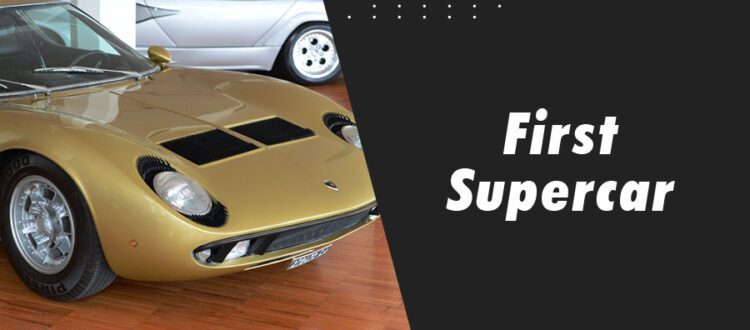First Supercar
When you think of a supercar, two things come to mind: performance and design. These cars have always attracted people’s attention as synonymous with speed and setting new standards in the automotive industry. But do you know how the story began and when the first supercar was invented?
If you want to know all the details, you have come to the right place. In the following, we will present the features of the best first supercar and its impact on creating future supercars.
Predecessors to the Supercar
Although we often use it today, the term supercar, also referred to as an exotic car, was not popularized or used in the past. Supercars were never precisely defined, but certain vehicles have significantly impacted the development of the first-ever supercar.
To find the forerunners of the supercar, we have to go back to 1935 when the Duesenberg SSJ appeared. This car was a pioneer when it came to power and performance.
At the time, the Duesenberg SSJ was a car that was twice as powerful as other vehicles. With its 400 horsepower, this car could cover 60 miles in less than eight seconds. With that, car lovers were introduced to the new possibilities the car’s engine offers.
Besides performance, supercars are defined by their elegance and design. This brings us to 1954 when the Mercedes-Benz 300 SL appeared. This car with the iconic gull-wing doors paved the way for supercars with improved design and aerodynamics. The Mercedes-Benz 300SL was followed by introducing the Jaguar E-type and Ferrari GTO before the first supercar as we know it today.
What Car Is the First Supercar?
So, what was the first supercar, and when was it presented for the first time? The Lamborghini Miura is regarded as a vehicle that altered public perception of supercars. This innovative marvel set new standards in the auto industry and paved the way for creating models with impressive performance and exceptional design.
Although many think of the Jaguar E-Type or Ferrari 250 GTO as the first supercars due to their looks and high price, they cannot compare to the features the Miura offers.
The beginnings
During the 50s and 60s, the Berlinette was a type of car that was synonymous with speed and luxury. These racing-inspired cars had a v12 engine under the long hood and a luxurious two-seater cabin. The Berlinetta was the inspiration for the creation of the Ferrari 250 GT series as well as the Lamborghini 350GT.
However, Lamborghini wanted to do something more and incorporate the Italians’ passion for racing cars into his cars. Therefore, three engineers from Lamborghini, Bob Wallace, Gian Paolo Dallara, and Paolo Stanzani, who were fans of car racing, came up with the idea of designing a supercar that would resemble the Formula One cars of the time.
Namely, the engine in Formula One cars was located in the rear, unlike many cars where the engine was located under the chassis. This was the starting point from which the idea of the Miura engine would be developed and the creation of the first supercar.
Features
Unlike many other supercars, the Lamborghini Miura is believed to be the first supercar to have a central-mounted engine. The prototype of this model was presented in 1965, and the first Lamborghini Miura was presented in 1966.
The interior of the car is typical of that time. The seats are set low, while the center console is tall and wide, which was atypical for the time. The dashboard, door panels, and seats were covered in high-quality leather, while the floor was covered in soft carpet.
Regarding the control system, this supercar features multiple gauges for oil pressure, fuel and engine temperature, and more. In addition, the Lamborghini Miura used a 3.9-liter V12 engine that could reach 350 hp. It needed 6.3 seconds to accelerate to 100 km/h.
Although this model was planned to be released in 30 units initially, this number changed with the growth of popularity. Ultimately, 275 units of this type were sold in three years.
Evolution of the Supercars
The appearance of the Lamborghini Miura has opened up new opportunities for creating unique supercars that will leave a mark on the auto industry. Over the years, several supercars have stood out for their design, extravagance, and performance. In the following, we will look at the most significant supercar models of their time.
1950s and 1960s
The postwar period may be one of the most important for supercars. With the appearance of the Lamborghini Miura, a new chapter begins in producing supercars with high performance and exceptional design. Besides the Miura, the Shelby Cobra and the Ferrari 250 GTO are the Supercars that marked that period.
These vehicles were notable for using huge displacement engines, such as the V8 and V12. In addition to power, car designers began to pay more attention to aerodynamics as an important factor in improving the performance of supercars.
1970s
In the 1970s, the production of supercars became more sophisticated, especially with the advancement of technology and the emergence of new materials. This is the period when turbo-road cars are mass-produced.
Such cars had advanced suspensions, improved aerodynamics, and turbochargers. We will mention the Porsche 911 Turbo, BMW 2002 Turbo, Lamborghini Countach LP400, and Panther 6 as representatives of this period.
1980s
The eighties were when supercars gained enormous popularity, but also when their value price increased. This period will be remembered for the intensified rivalry between Ferrari and Porsche. Namely, Ferrari presented the iconic F40 model, which is still popular today. In response to Ferrari, Porsche introduced the 959 model on the market.
1990s
The nineties were a period when it was proven that supercars were not just vehicles intended for special events or occasions. During this period, supercars were made to preserve their performance and design attributes while being suitable for daily use.
Proof of that is the Honda NSX, which gained great popularity after it was introduced to the market. Apart from Honda, there were also models from other manufacturers, including Bugatti EB 110, Ferrari F50, Porsche GT1, Mercedes-Benz CLK GTR, and Jaguar XJ220.
2000s
Supercars evolved and continued to push the boundaries of performance in the 2000s. This is when aerodynamics is considered, and supercars are constructed from advanced composite materials.
Incorporating the latest technology has led to the creation of exceptional supercar models. The most notable models in this period are the Ferrari Enzo, Bugatti Veyron, Mercedes-Benz SLR McLaren, C6 Chevrolet Corvette ZR1, and Aston Martin One-77.
2010s
During this period supercars followed the trends in the automotive industry in order to improve standards and performance. Accordingly, many models with advanced electronics and hybrid technology have appeared on the market.
We will mention the Ferrari LaFerrari and the Porsche 918 Spyder as models that stand out. These supercars made a fusion of the latest technology, design, and high performance.
Supercars in the Future: What to Expect
So, in which direction is the supercar industry headed, and what can we expect? This question is difficult to answer because there are several factors on which the future of supercars depends.
First, the harmfulness of the internal combustion engine and environmental protection are considered here. If such engines are replaced, it will be disappointing for many supercar fans, especially those who are fans of the sound of the car engine.
On the other hand, models that have used hybrid technology have already appeared on the market. Models like the Porsche 918 Spyder, Ferrari LaFerrari, Honda NSX, and McLaren Artura have their fans who are slowly getting used to the new hybrid technology.
Besides hybrid supercars, it is worth mentioning Concept One, Rimac Automobili’s first-ever electric supercar. With the advent of electric cars, it was thought impossible to apply such technology to supercars.
Above all, the main problem was the weight of the battery, which prevented electric cars from achieving high performance similar to conventional supercars. However, such a problem was overcome by Concept One, which gives promising results in terms of engine power and performance.
Conclusion
Undoubtedly, the Lamborghini Miura is the stimulant for many supercars today. This vehicle popularized the term “supercar” and gave the automobile industry a new direction.
The combination of high performance with elegant design has become a winning combination and inspiration for many supercar manufacturers. Proof of that is the Lamborghini Countach, the most desirable car in the 70s and 80s that was every car lover’s dream.
We hope you enjoyed the journey through the timeline where the first supercar set new automotive industry standards. The Lamborghini Miura has always been and will be the inspiration for many future supercars that will push the boundaries of engine performance.






